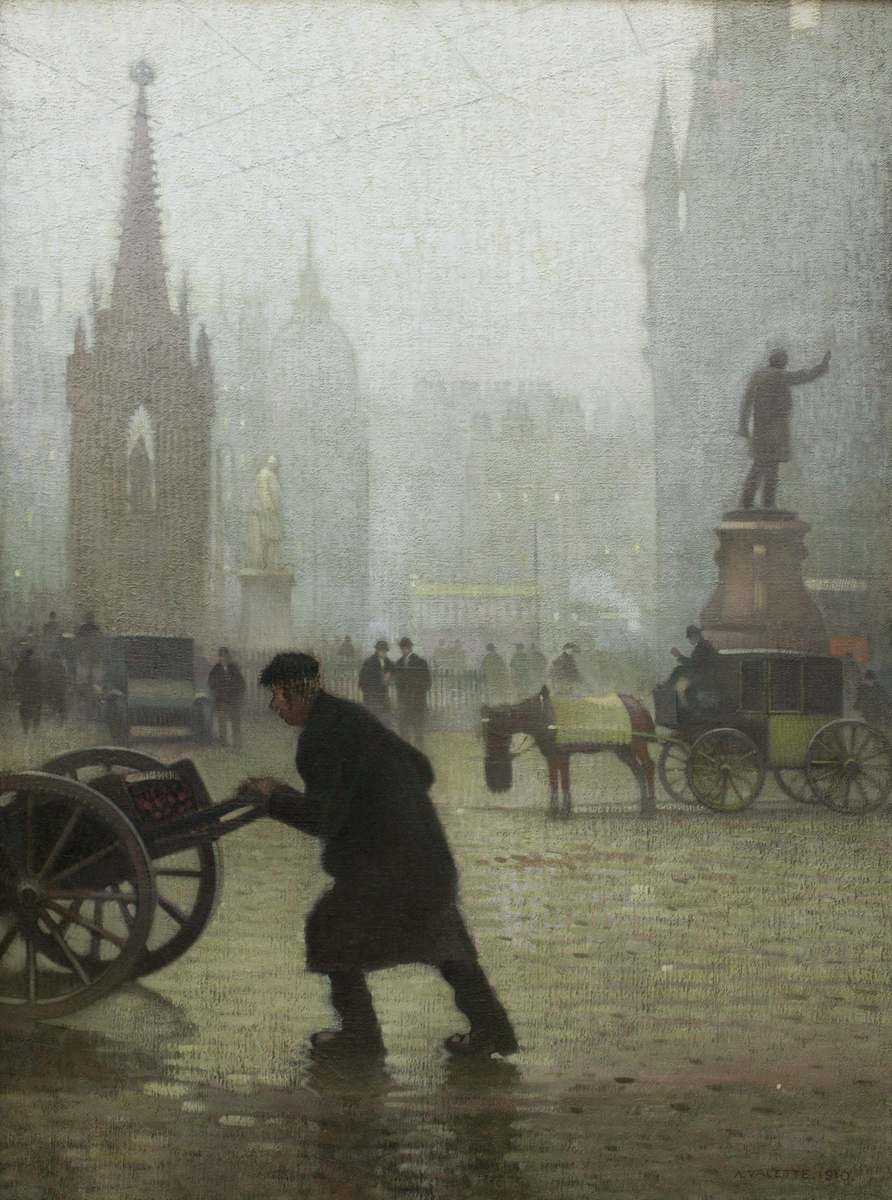Albert Square, Manchester
Summary
An atmospheric, smog-filled view of Albert Square, Manchester, seen from the southwest side. In the foreground is the dark figure of a man, wearing a cloth cap and knee-length coat, pushing a handcart, his figure silhouetted against the wet cobbles. Overhead is a grid of cables. On the far side of the street, to the right of the scene, is parked a hansom cab beneath the statue of Gladstone - the horse feeds from a nose-bag as the driver also rests; behind the statue looms the hazy silhouette of part of the Town Hall. To the left of the scene, a group of figures congregate around a motorcar parked beneath the Albert Memorial and the statue of Oliver Heywood to the right. Beyond are the forms of figures making their way across the square, illuminated with street lights, seen against a further background of the extremely hazy surrounding buildings.
Display Label
Channel Crossings English and French Impressionism and Post-Impressionism from the collection of Manchester Art Gallery This display looks at the allure and excitement of French art for a generation of English and Scottish painters emerging from the claustrophobia of late Victorian painting. Breaking with the Classical rigours of the Academy and the Salon, the artists who came to be known as the Impressionists painted naturalistic scenes with loose and quickly applied brushwork to convey the effects of light and the natural colours of shadows which had previously been rendered with blacks and browns. They explored the French countryside where they learned how to paint directly en plein air closely studying the changing effects of the seasons. Making regular visits to or studying in Paris, English and Scottish artists were in turn enthralled by these painterly discoveries. The new method of painting they then applied to the English landscape, to still lifes, portraits and interiors. Painters of the New English Art Club like George Clausen, John Singer Sargent and Philip Wilson Steer combined the subject matter of late Victorian genre scenes with the new style. Works by these artists and others are here shown alongside a few choice examples of French Impressionism from the collection and by the fore-runners of Impressionism; Eugène-Louis Boudin, Charles Daubigny and Johan Jongkind. While the English artists went to France the French painters and their dealers, such as Paul Durand-Ruel, escaped the Franco-Prussian war of 1870-71 and went to London. Their paintings were seen in England and some were even bought by Manchester collectors. In the Edwardian era newer developments in French art inspired English and Scottish artists on their cross-Channel trips and via a series of influential London exhibitions. The high-keyed colour and bold lines of the Post-Impressionist paintings of Paul Gauguin and Vincent Van Gogh were now huge influences on the artists of the Camden Town Group such as Harold Gilman and Charles Ginner. Later still Matthew Smith was to take his inspiration directly from Henri Matisse under whom he studied in Paris.
Object Name
Albert Square, Manchester
Creators Name
Date Created
1910
Dimensions
Canvas: 152cm x 114cm
Frame: 176.5cm x 138.6cm
accession number
1928.37
Place of creation
Manchester
Support
Jute
Medium
Oil paint
On Display
Manchester Art Gallery - atrium - ground floor
View all
Credit
Purchased from the Artist
Legal
© Manchester Art Gallery

